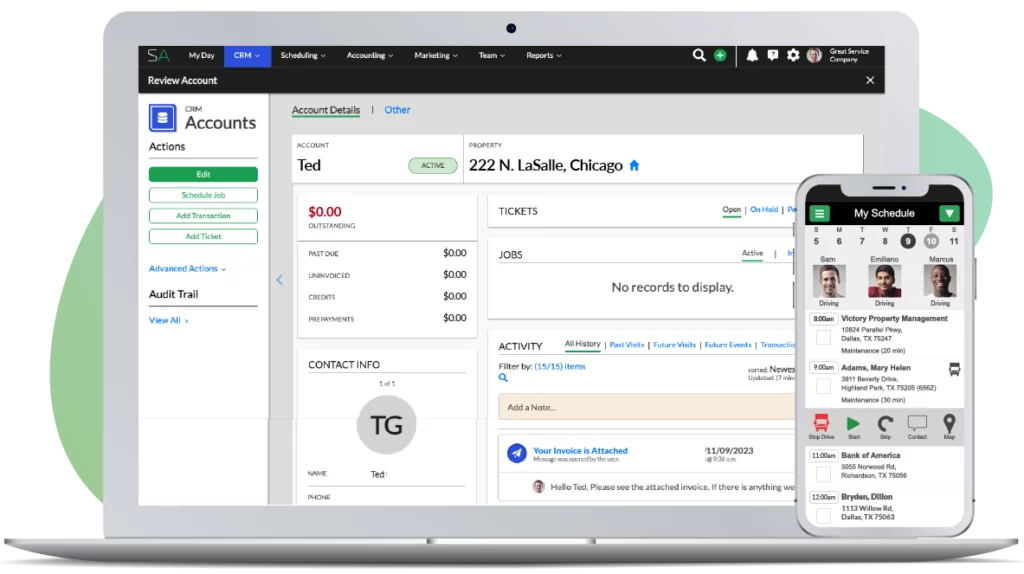How do you know what the optimal lawn care crew size is? In this video, Jonathan gives you some factors to consider whether you are just starting out or simply trying to become more efficient.
What factors go into determining the best lawn care crew size for your company?
I believe it’s really important to know that as your company changes, your crew size will change. A company that’s just getting started that has 1 crew and grows to 2 to 4 crews will change just as a company that has 10 crews and grows to 20 to 40 crews.
As an example, you as the owner are going to learn more. You’re going to learn how to operate more efficiently. You’re going to learn how to possibly market better to build better density. Your people are going to improve in terms of their ability, their skill set, their speed. Your understanding of what real quality is and what real speed is and what you should expect from your team will change. You could have 5 employees that you consider fantastic. The 6th employee that you hire shows you the world and is just heads above everyone else and suddenly you realize there’s a new benchmark here. There’s a new level of performance and that could completely make you rethink what your crew size should be or how your company could potentially operate.
Other factors to consider are your client mix and whether you are predominantly residential or commercial. Some of the points I’ll make in a moment will better clarify what I mean by that, but residential versus commercial is an absolute consideration. There is a different expectation level for quality for residential versus commercial and of course it depends on the type of properties your serving. I tend to think that the expectation is higher on residential then it is on commercial.
Again, it depends on the commercial property we’re talking about. If you’re talking about the high-end Homeowners Association or Condo Association in a very affluent area it might have a very high level of expectation in terms of quality, but a similar HOA in a non-affluent area consisting of homes at a much lower price point might require and support far less in regards to the level of quality because that Homeowners Association can only afford so much. Your client mix is going to determine how many people a crew requires because it often will affect the level of detail that’s being delivered at that property.
Another example would be equipment. Residential versus commercial mix is also going to affect this because it determines the type of equipment. If you’re managing smaller residential properties you might be okay with 21 inch motors and walk behinds. Whereas, if you’re dealing with large commercial you’re dealing with more riders. Your large commercial might require 3 riders and your smaller commercial properties may only require 1. The different equipment is going to completely determine how many people need to be on the truck because the people on the truck have to be capable of operating the equipment.
For example, if you are maintaining a number of properties that require, let’s say 3 riders for commercial, then that means you don’t want 3 riders sitting on the truck most of the day. You don’t want 2 sitting there while 1 guy is on a rider. You need 3 people on 3 riders. That way you’re utilizing your asset. All of your equipment is in play and all of your equipment is working. That immediately tells you that you need at least 3 men on your truck just to perform the mowing…the turf maintenance.
Now, how many weed eaters do you need? How many guys do you need to edge? How many guys do you need to blow? How many detail people will you need? The size of the property is going to determine the type of equipment, which is going to determine the skill level you need and the number of people you need.
Another consideration would be how many properties do you have. If you want to avoid a scenario where you have to buy more and more trucks and more and more equipment, then what you can often do is place more equipment and more people onto the very same truck. As an example, if I’m a smaller company with a small set of commercial properties, I might determine that it’s fully acceptable to let a crew of 3 or 4 be on one of my big commercial properties for the entire day.
Now, as my business grows and I need to have more individuals, I need more people and more equipment available to me to perform more jobs. I might look at my business and say, all right, rather than adding another $30,000 or $40,000 truck, the trailer, and all the equipment that goes with it, I can just add 1 or 2 more people to that same crew and they could finish the job that they’re doing in a full day now in half a day. I could use that same truck, that same equipment and now I could have it go service another property. That’s a very common sense example but that’s an absolute consideration in how can you better utilize the assets that you have.
On a side note, I believe it’s always better to make your assets, your equipment and your trucks, work harder than it is to make your labor carry the day. Labor is extremely expensive. Labor’s a risk. Labor comes with opportunity cost and risk so you want to put most of your work onto your assets. You want to be running those mowers all day. You don’t want a mower sitting in a truck half the day.
That brings us to another point. How many trucks and how much equipment do you have available to you? When you’re small you might run 1 or 2 crews simply because of the property mix. You have some small commercial or small residential and you have a few larger properties. To do those larger properties you have to have a rider, or you have to have some walk behinds or whatever the case may be. You have some larger equipment, but you just haven’t sold enough big work yet to keep that piece of equipment working all day. You’re forced to send a crew out and use the rider for X number of hours a day and then let that rider sit for X number of hours a day.
As your business grows because your sales and marketing has improved, your job is to make sure that rider is running constantly all day long every day. As you grow your company so that it’s capable of doing that, you have to add more people to the crew. You have to change the structure and shape of that crew. For all the examples I’ve just given, I think it’s clear that for the size of the properties that you’re taking care of significantly impacts, again, the equipment you have to have and therefore significantly impacts the number of individuals that you have on the crew on the truck.
The quality of your foreman is also of importance. We’re in a very tight labor market. It’s challenging sometimes to find the ideal person that you want. Therefore, if you have someone that’s a little less skilled, a little less capable of managing, that will determine how much they can manage and how efficiently they can manage that crew.
I’ll use another commercial example. Let’s say you’re maintaining a very large commercial property that could support 8 individuals. If you have a foreman and he’s the only person available to you and he simply cannot efficiently manage seven other individuals and keep you in check budget wise, then you might be forced to run a smaller crew and spend more time on that property until you can put the right person on it.
The point there is that it’s another example of the evolution of the business. You have to make crew staffing decisions based on who’s available to you and what they’re capable of.
Also, you have to consider route density in both commercial and residential. If you’re building out a new residential route of small to medium size properties and you have not fully built this route out, it’s not super tight, that means you’re sending your truck a further distance. Then there’s a lot of non-billable time in the route, having to move from property to property. I might be able to, in a very dense route, justify putting 3 men on this truck. The problem is that I now have 3 men all incurring a lot of non-billable time. They are spending time driving in the truck, loading the truck, getting ice, and doing all the other activities that go into a typical day. If I’m not efficient in terms of route density and I put more people into the truck, I incur more non-billable time.
In a scenario where you’re building a route, then it might make sense to run fewer people, let’s say 2 people, because now you only have 2 people incurring the non-billable time. Again, this is why your business is a moving, living thing. It’s constantly evolving as your sales and marketing team, or as you as the owner builds out that route.
You also have to consider your rotation of services. This applies to both residential and commercial. If you are a company that just shows up and mows the lawn and then moves on to the next property, that is completely different than a company that shows up, mows the lawn, trims the bushes, hand weeds the beds, spot sprays with Roundup and performs a couple of other services. You have to have the right people on the truck to do the detailed work whether it’s residential or commercial. The more detail work you have to do, the more individuals that crew supports. In addition, the more detail work you have to do at a high frequency, the more individuals that crew supports.
For example, if in your market you serve large commercial properties and they’re on a rotation. You rotate through the properties and you prune the shrubs in different areas of the property and you run through about a monthly rotation. That might be the case in the southern part of the US, whereas if you’re in the northern part of the US, maybe you could run through a rotation where you prune the shrubs every two months. The frequency at which you have to perform that detailed work, hand weed the beds and prune the bushes will necessitate additional individuals because the individuals performing the detail work will have more to do each week. Therefore, you potentially need more of those individuals.
Likewise, if you’re running residential and you have, from a sales and marketing standpoint, only 25% of your route includes pruning the bushes and hand weeding the beds, that’s a consideration because you only have so much detail work to do. So, now how many people do you have on the crew to perform that work? How many people have to be skilled?
All of these are factors. I haven’t given the exact answer on how you do it, but I’ve given you all of the considerations. If you’re a fast-growing company, then your structure might change in a quarter. If you’re not a very fast growing company it might change annually. These are things to pay attention to and be aware of. The way that you pay attention is you watch your job costing numbers on every single job. When you see your job costing numbers get out of alignment with the per man hour rate that you’re trying to achieve, or you’re outside the budgeted hours that you bid the contract for, or sold work that you know that you have an issue, then you need to look at it.
Then, I would suggest that the wintertime is the best time to re-optimize the business and look for performance improvements in how you can squeeze more production out of the company, how you can eliminate more of the non-billable time, and how you can generate more profit. You optimize often times in the winter but you adjust throughout the season. In a fast-growing company you’re adjusting frequently. You should always be trying and testing different scenarios and challenging what you see your competitors doing.




One Reply to “What Factors Go Into Determining Your Lawn Care Crew Size?”
I like how you said that it’s important to know how to decide the right lawn care crew size. I agree that it totally depends on how you’re trying to run the thing. A friend of mine down the street sends a team of five people to do the neighbor’s lawn, but my brother in law did it with just two. It was the same service but different companies, and they were both able to make a profit.